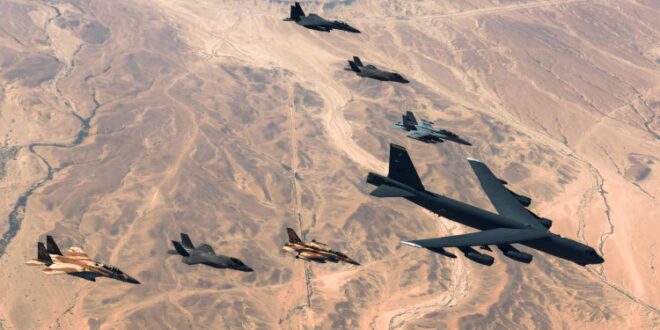This week, the United States Central Command (CENTCOM) concluded what it called on social media, “the largest ever U.S.-Israel combined exercise.” Juniper Oak 2023 was the first of its name and massive in terms of scale, scope, and complexity. Building on previous bilateral exercises like the biennial Juniper Cobra and Juniper Falcon, the drills reasserted U.S. support for partnerships, deterrence, and integration, despite posture reductions and continued concern among partners about Washington’s commitment to the Middle East.
Strategically, the exercise demonstrated how the U.S. can rapidly flow in forces from across the globe, deploy them across combatant command boundaries, and shift from within the CENTCOM area of responsibility, all while maintaining commitments in other priority theaters.
Juniper Oak was also unique because bomber task force and carrier strike group availability significantly condensed the inception-to-execution timeline. U.S. and Israeli planners began work in November 2022, squeezing a year’s worth of preparation into under 90 days. Both partners exhibited the level of transparency, trust, and sophistication required to coordinate, deploy, support, and execute a rapid response to any regional contingency.
The result was a combined, multidomain exercise that entailed a large-scale live-fire event with over 6,400 U.S. and 1,100 Israeli personnel; 140 aircraft, including B-52 bombers, F-35, F-15, F-16, and FA-18 fighters, AC-130 gunships, KC-46 aerial refueling planes, AH-64 attack helicopters, as well as MQ-9 combat drones; 12 naval vessels, including a carrier strike group; advanced artillery rocket systems, including High Mobility Artillery Rocket Systems (HIMARS) and Multiple Launch Rocket Systems (MLRS); along with special operations, infantry, and space forces. Logisticians and civil engineers supported force reception and beddown at military bases in Israel, improving facilities and providing sustainment to include over 180,000 pounds of ammunition.
While defense officials were clear to point out that the exercise did not address a specific country, the week-long drills surely signaled U.S. and partner capabilities to Iran, as well as global competitors like China and Russia, reinforcing the National Defense Strategy (NDS) concepts of campaigning and integrated deterrence through continued integration with allies and partners.
Absent from much of the coverage of Juniper Oak was meaningful discussion about the impact of a U.S.-Israeli bilateral exercise on other regional partners, how they might view the outcomes, and the next steps needed to increase regional integration — a concept that has proved difficult for numerous political, cultural, and historical reasons. Despite the inherent challenges, CENTCOM continues to push for partner integration, making clear that the intent is for Juniper Oak to serve as a template for future exercises with other partners.
Despite Juniper Oak’s success, there is still potential for criticism from Gulf Arab partners, who could feel slighted by such a sizeable exercise focused only on Israel or might view the exercise as escalatory. A senior CENTCOM official interviewed by the author messaged a desire to continue and expand exercise participation multilaterally, pointing out that the command will invite Arab partners to the next International Maritime Exercise (IMX) — the largest naval exercise in the region. Eager Lion, Bright Star, Eagle Resolve, and other long-standing regional exercises also provide opportunities for increased multilateral cooperation, integration, and sophistication across multiple domains.
The same CENTCOM official also confirmed ongoing high-level coordination and communication with Gulf Arab partners about Juniper Oak. Reaffirming this message, the CENTCOM commander, General Michael “Erik” Kurilla, pledged to “take the lessons learned from Exercise Juniper Oak and share and incorporate them with all our partners across the CENTCOM region.” The command will continue partner cooperation as part of its campaign plan, using the exercise program, building from events focused on limited scope and single domains to more sophisticated and integrated drills intended to deter adversaries.
The final question facing the U.S. and Israel is how to assess the results of Juniper Oak and measure its effectiveness. On an operational level, the training and interoperability value is clearer because it is easier to evaluate how well exercise participants performed actions to put ordnance on target, rescue downed aircrews, defend against attack craft, or refuel aircraft on time.
On a strategic level, determining the reactions of both adversaries and partners will be more difficult to gauge, particularly because deterrence is hard to measure and requires consistent pressure and vigilance. Additionally, there is always the potential that Iran could respond with escalatory attacks aimed at discouraging Arab partners from participating in future multinational exercises.
The best outcome is enhanced U.S. engagement with Middle East partners who recognize the value in the Juniper Oak exercise and are willing to increase their own participation in what a senior defense official speaking with the author on background called a “steady drumbeat of exercising” across the CENTCOM region, both with the U.S. and with each other.
Juniper Oak and future CENTCOM exercises will continue to reinforce U.S. commitment, improve regional security and stability, and deter malign actors from exploiting the abandonment narrative. Despite posture reductions, the U.S. is still engaged in the Middle East. And it remains able to demonstrate its unmatched capability and willingness to rapidly deploy sufficient military personnel and equipment into the region to both deter adversaries and support its partners.
 Eurasia Press & News
Eurasia Press & News




